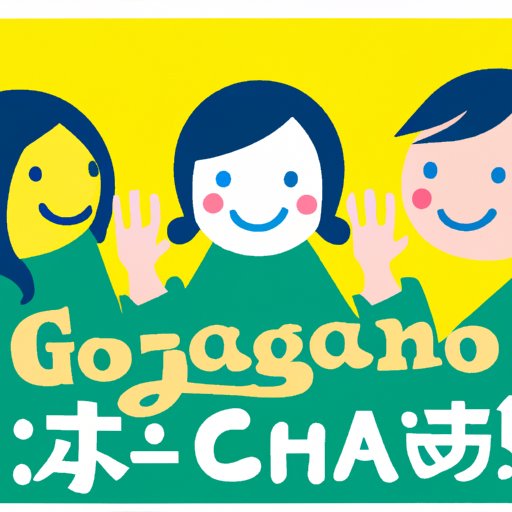Introduction
Have you ever found yourself struggling to say hello in Japanese? With a variety of greetings available, it can be overwhelming to know which one to use in a given context. But it is important to know how to greet in Japanese, as proper greetings are a way to show respect and build relationships in Japanese culture. In this article, we will explore 7 different greetings and phrases for saying hello in Japanese, as well as provide tips on mastering Japanese greetings.
7 Different Greetings for Saying Hello in Japanese
Let’s start with the basics. Here are 7 different greetings that you can use to say hello in Japanese:
- Kon’nichiwa (こんにちは): This is the most common greeting in Japanese, and it is equivalent to saying “hello” in English. It is typically used during the day or in a formal setting.
- Ohayou gozaimasu (おはようございます): This is a greeting used to say “good morning” in Japanese. It is appropriate to use until around 10 a.m.
- Konnbanwa (こんばんは): This phrase is used to say “good evening” in Japanese. It is a popular greeting used after sunset.
- Arigatou gozaimasu (ありがとうございます): This phrase means “thank you” in Japanese. It can be used as a greeting in some contexts, such as thanking a friend for meeting you at a restaurant.
- Shitsurei shimasu (失礼します): This is a formal greeting used when entering or leaving someone’s home or office. It can be translated to mean “excuse me for interrupting.”
- Yoroshiku onegaishimasu (よろしくお願いします): This phrase is used to express trust and respect when meeting someone for the first time, and it can be used in formal and informal settings. It can be translated to mean “Please be kind to me.”
- Genki desu ka (元気ですか): This phrase means “how are you” in Japanese. It is usually used as a casual greeting.
Each of these greetings can be used in different contexts, depending on the time of day and the formality of the situation. Understanding these nuances can help you communicate more effectively in Japanese.
Master the Art of Greeting in Japanese: 7 Essential Phrases
While the above greetings are commonly used, there are also 7 essential phrases that are helpful for mastering Japanese greetings:
- Irasshaimase (いらっしゃいませ): This phrase is used by store clerks to welcome customers to their store.
- Otsukaresama desu (お疲れ様です): This is a phrase used to acknowledge someone’s hard work. It is often used in the workplace or after a task is completed.
- Doumo arigatou gozaimasu (どうもありがとうございます): This phrase means “thank you very much” in Japanese. It is a more formal way of expressing gratitude and can be used in many contexts.
- Sumimasen (すみません): This is a phrase used to apologize for bothering someone or for making a mistake. It can also be used to get someone’s attention in a polite way.
- Gomen nasai (ごめんなさい): This is a more casual way to apologize in Japanese. It is often used between friends or in informal settings.
- Ittekimasu (行ってきます): This phrase is used to say “I’m leaving” before going out. It is often responded to with “Itterasshai (行ってらっしゃい),” which means “take care on your journey.”
- Tadaima (ただいま): This phrase is used to say “I’m home” when returning home. It is often responded to with “Okaeri nasai (お帰りなさい),” which means “welcome back.”
Learning these phrases in addition to the typical greetings can help you become more proficient in Japanese communication.
Konnichiwa! How to Properly Say Hello in Japanese
‘Kon’nichiwa’ is the most common greeting in Japanese. It is pronounced “koh-nee-chee-wah”. The word is made up of two kanji characters: 今日 (kon-nichi), which means “today,” and は (wa), which is a particle used to indicate the topic of the sentence. Because ‘kon’nichiwa’ is used during the day or in formal settings, it is important to use the proper tone and inflection when saying it.
When greeting someone with ‘kon’nichiwa,’ it is polite to bow slightly while saying the word. This shows respect and acknowledges the other person’s presence. If someone greets you with ‘kon’nichiwa,’ it is customary to respond by repeating the phrase back to them.
The Many Ways to Say Hello: A Guide to Japanese Greetings
While we have covered some common Japanese greetings, there are many other greetings you can use to connect with Japanese people:
- Ohisashiburi desu (お久しぶりです): This phrase is used to greet someone you haven’t seen in a while.
- Ogenki desu ka? (お元気ですか?): This phrase means “how are you doing?” and is a more casual greeting.
- Oyasumi nasai (おやすみなさい): This greeting is used to say “good night” in Japanese.
- Moshi moshi (もしもし): This is an informal greeting used to answer the phone in Japan.
- Tanoshii o-kyaku-san (楽しいお客さん): This phrase can be used to greet a regular customer at a store or restaurant and translates to “fun guest.”
- Irrashaimasei masei (いっらしゃいませー): A shortened version of ‘irashaimase,’ this phrase is a more casual way to welcome someone to a store or restaurant.
- Kaerimashita (帰りました): This phrase means “I’ve come back” and is used when someone has returned home or to their workplace after being away.
When choosing a greeting, consider the context and relationship with the person you are greeting. Using a more unique greeting can show that you are making an effort to connect with them on a deeper level.

Saying Hello in Japan: 7 Unique Phrases to Learn
Here are 7 unique phrases that you can use to stand out and show respect:
- Okini (お気に): This is a regional greeting used in Hiroshima and surrounding areas. It is similar in meaning to ‘arigatou,’ but more casual.
- O-jo-su-mi-na-sai (お・じょ・す・み・な・さい): This is a unique way to pronounce ‘oyasumi nasai’ and is used mainly in Osaka.
- Meghane me tetteite kudasai (めがねめって返ていてください): This phrase is used to say “Please adjust your glasses.” It is seen as a polite way to point out someone’s eyewear.
- Mada mada (まだまだ): This phrase can be translated to “not yet” and is often used in sports to show that you are not giving up.
- Yokatta desu (よかったです): This phrase means “that’s good” and can be used to express relief or gratitude in a given situation.
- Saikin dou desu ka (最近どうですか): This phrase means “how have you been recently?” and is a more casual way to greet an acquaintance.
- Atsui desu ne (暑いですね): This phrase means “it’s hot, isn’t it?” and is a common opening line in conversations during the summer months.
Using unique phrases can show that you have a deeper understanding of Japanese culture and can lead to more meaningful connections with Japanese people.
Hello, Japan! Seven Ways to Greet People in Japanese
Here is a comprehensive list of 7 different greetings, and when they are most appropriate to use:
- Kon’nichiwa (こんにちは): use during the day or in formal settings
- Ohayou gozaimasu (おはようございます): use until around 10 a.m. to say “good morning”
- Konnbanwa (こんばんは): use after sunset to say “good evening”
- Arigatou gozaimasu (ありがとうございます): use to say “thank you” in a variety of contexts
- Shitsurei shimasu (失礼します): use when entering or leaving someone’s home or office
- Yoroshiku onegaishimasu (よろしくお願いします): use when meeting someone for the first time, both formal and informal settings
- Genki desu ka (元気ですか): use as a casual greeting to ask “how are you?”
Each of these greetings can be used in different contexts, and understanding these nuances can help you navigate Japanese culture and build strong relationships.
Greet Like a Native: 7 Japanese Phrases to Say Hello
Here is a comprehensive guide to Japanese greetings and essential phrases, perfect for beginners:
- Kon’nichiwa (こんにちは): use during the day or in formal settings
- Ohayou gozaimasu (おはようございます): use until around 10 a.m. to say “good morning”
- Konnbanwa (こんばんは): use after sunset to say “good evening”
- Arigatou gozaimasu (ありがとうございます): use to say “thank you” in a variety of contexts
- Shitsurei shimasu (失礼します): use when entering or leaving someone’s home or office
- Ittekimasu (行ってきます): use when leaving a place to say “I’m leaving”
- Tadaima (ただいま): use when returning home to say “I’m home”
Additional tips for mastering Japanese greetings include practicing pronunciation, observing Japanese people’s interactions, and actively incorporating greetings into daily interactions with Japanese people.
Conclusion
Learning how to say hello in Japanese is an important step in building relationships and showing respect in Japanese culture. In this article, we explored 7 different greetings and phrases for saying hello in Japanese, along with tips for mastering the art of greeting in Japanese. By incorporating these greetings into your daily interactions, you can deepen your understanding and appreciation of Japanese culture.
